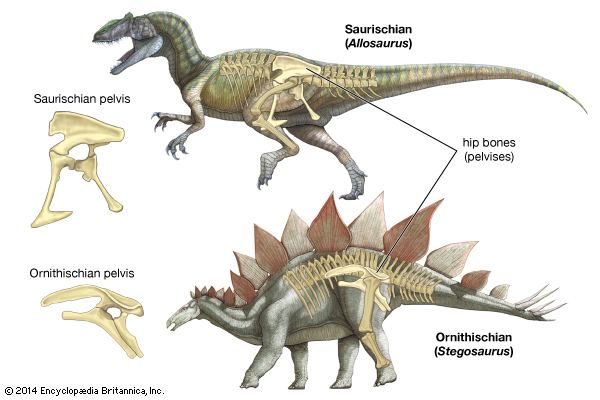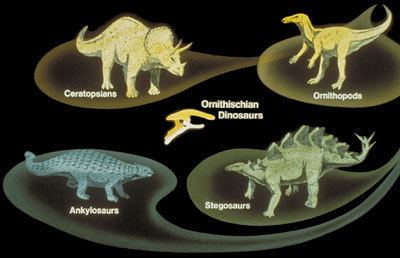Higher classification Dinosaur | Phylum Chordata Scientific name Ornithischia Rank Order | |
 | ||
Lower classifications | ||
Who were the ornithischian dinosaurs
Ornithischia (/ɔːrnᵻˈθɪskiə/ or-ni-thiss-kee-ə) is an extinct clade of mainly herbivorous dinosaurs characterized by a pelvic structure similar to that of birds. The name Ornithischia, or "bird-hipped", reflects this similarity and is derived from the Greek ornitheos (ορνιθειος) meaning "of a bird" and ischion (ισχιον) meaning "hip joint". Birds are members of the saurischian, or "lizard-hipped", dinosaurs.
Contents
- Who were the ornithischian dinosaurs
- Lecture 49 saurischian vs ornithischian dinosaurs
- Anatomy Diagnostic CharactersEdit
- Bird hipEdit
- PredentaryEdit
- Other characteristicsEdit
- EcologyEdit
- TaxonomyEdit
- PhylogenyEdit
- References

Ornithischia is well-supported as one of the two major groups in the Dinosauria. Many characteristics define the group though most are thought to be linked to herbivory.

Ornithischians with well known anatomical adaptations include the ceratopsians or "horn-faced" dinosaurs (e.g. Triceratops), armored dinosaurs (Thyreophora) such as stegosaurs and ankylosaurs, pachycephalosaurids and the ornithopods. There is strong evidence that certain groups of ornithischians lived in herds, often segregated by age group, with juveniles forming their own flocks separate from adults.

Some were at least partially covered in filamentous (hair- or feather- like) pelts, and there is much debate over whether these filaments found in specimens of Tianyulong, Psittacosaurus, and Kulindadromeus may have been primitive feathers. In the alternative evolutionary hypothesis for dinosaurs that was proposed by Baron, Norman & Barrett in the journal Nature in 2017, the presence of such features in Ornithischia as well as Theropoda was interpreted as possible evidence for feathers being an ancestral condition of the clade Ornithoscelida.
Lecture 49 saurischian vs ornithischian dinosaurs
Anatomy & Diagnostic CharactersEdit
In 1887, Harry Seeley divided Dinosauria into two clades: Ornithischia and Saurischia. Ornithischia is a strongly supported clade with an abundance of diagnostic characters (common traits). The two most notable traits are a "bird-like" hip and beak-like predentary structure though they shared other features as well.
"Bird-hip"Edit
The ornithischian pelvis is "opisthopubic" meaning that the pubis points down and back (posterior) parallel with the ischium (Figure 1a). Additionally, the pelvis has a forward-pointing process to support the abdomen. This results in a four-pronged pelvic structure. In contrast to this, the saurischian pelvis is "propubic" meaning the pubis points toward the head (anterior), as in ancestral reptiles (Figure 1b).
The opisthopubic pelvis independently evolved at least three times in dinosaurs (in ornithischians, birds and therizinosauroids). Some argue that the opisthopubic pelvis evolved a fourth time in the clade Dromaeosauridae but this is controversial as other authors argue that dromeosaurids are mesopubic.
PredentaryEdit
Ornithischians share a unique bone called the predentary (Figure 2). This unpaired bone is found at the front of the lower jaws and presumably aided ornithischians in cropping vegetation.
Other characteristicsEdit
EcologyEdit
Ornithischians shifted from bipedal to quadrupedal posture at least three times in their evolutionary history and have been shown to have been capable of adopting both postures early in their evolutionary history.
Most ornithischians were herbivorous. In fact, most of the unifying characters of Ornithischia are thought to be related to this herbivory. For example, the shift to an opisthopubic pelvis is thought to be related to the development of a large stomach or stomachs and gut which would allow ornithischians to digest plant matter better. The smallest known Ornithischians are Fruitadens haagarorum. The largest Fruitadens individuals reached just 65–75 cm. Previously, only carnivorous, saurischian theropods were known to reach such small sizes. At the other end of the spectrum, the largest known ornithischians reach about 15 meters (smaller than the largest saurischians).
However, not all ornithischians were strictly herbivorous. Some groups, like the heterodontosaurids, were likely omnivores. At least one species of ankylosaurian, Liaoningosaurus paradoxus, appears to have been at least partially carnivorous, with hooked claws, fork-like teeth, and stomach contents suggesting that it may have fed on fish.
There is strong evidence that some ornithischians lived in herds. This evidence consists of multiple bones beds with large numbers of the same species in different age classes who died simultaneously.
TaxonomyEdit
The simplified taxonomic list of ornithischian groups presented here follows a summary published by Thomas R. Holtz, Jr. in 2011.
PhylogenyEdit
Ornithischia is a branch-based taxon defined as all dinosaurs more closely related to Triceratops horridus Marsh, 1889 than to either Passer domesticus (Linnaeus, 1758) or Saltasaurus loricatus Bonaparte & Powell, 1980. Genasauria comprises the clades Thyreophora and Neornithischia. Thyreophora includes Stegosauria (like the armored Stegosaurus) and Ankylosauria (like Ankylosaurus). Neornithischia comprises several basal taxa, Marginocephalia (Ceratopsia and Pachycephalosauria), and Ornithopoda (including duck-bills (hadrosaurs), such as Edmontosaurus). Cerapoda is a relatively recent concept (Sereno, 1986).
The cladogram below follows a 2009 analysis by Zheng and colleagues. All tested members of Heterodontosauridae form a polytomy.
Cladogram after Butler et al., 2011. Ornithopoda includes Hypsilophodon, Jeholosaurus and others.
